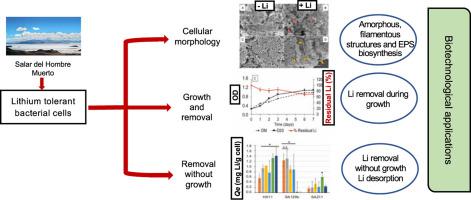Journal of Environmental Chemical Engineering ( IF 7.4 ) Pub Date : 2021-01-18 , DOI: 10.1016/j.jece.2021.105099 Fabiana Lilian Martínez , Verónica Beatriz Rajal , Verónica Irazusta

|
The interaction of lithium with halotolerant microorganisms was evaluated to determine its effect on bacterial isolates and its removal from the surrounding environment. The observed effects on bacterial cells included different biomass production, exopolysaccharide synthesis, variation in morphology, and spore formation under the presence of Li. They allowed microorganisms not only to tolerate 20–30 g/L LiCl but also to remove it from the surrounding environment. The microbial-metal interactions were verified through lithium removal from the growth medium and also from aqueous solutions using fresh cultures. Interestingly, in presence of LiCl, bacteria from the genus Bacillus sp. (strains FAMB1, SA313, HX11, and HA120a) produced similar amounts of biomass and higher amounts of exopolysaccharides in comparison to the condition without LiCl added. These isolates, except for FAMB1, were also efficient in Li removal in all the evaluated conditions, removing around 30% of initial Li during growth and 50% from aqueous solutions. Furthermore, fresh cultures of Micrococcus luteus SA211, Bacillus sp. FAMB1, Micrococcus sp. M12, Brevibacterium sp. SX139 and Kocuria sp. SA129b removed Li from the aqueous solutions, and only SA129b released the metal back to the solution after incubating for 6 h. Finally, Bacillus sp. HX11, Bacillus sp. HA120a, Kocuria sp. SA129b and Brevibacterium sp. SX139 developed an efficient and environmentally-friendly removal of lithium from aqueous matrices in short periods, showing specific lithium removal values between 1.0 and 1.4 mg Li/g cells.
中文翻译:

使用El Salar del Hombre Muerto的耐盐细菌从水溶液中去除锂
评估了锂与卤代环微生物的相互作用,以确定其对细菌分离物的影响及其从周围环境中的去除。在锂的存在下,观察到的对细菌细胞的影响包括不同的生物量产生,胞外多糖合成,形态变化和孢子形成。他们不仅允许微生物耐受20– 30 g / L LiCl,而且还可以将其从周围环境中清除。通过使用新鲜培养物从生长培养基以及水溶液中除去锂,从而验证了微生物与金属的相互作用。有趣的是,在LiCl存在下,芽孢杆菌属的细菌sp。与未添加LiCl的条件相比,(菌株FAMB1,SA313,HX11和HA120a)产生相似数量的生物量和更高数量的胞外多糖。除FAMB1外,这些分离物在所有评估条件下均能有效去除Li,在生长过程中去除了大约30%的初始Li,从水溶液中去除了50%。此外,微球菌SA211,芽孢杆菌属的新鲜培养物。FAMB1,微球菌属。M12,短杆菌属。SX139和Kocuria sp。温育6小时后,SA129b从水溶液中除去了Li,只有SA129b将金属释放回溶液中。最后,芽孢杆菌属。芽孢杆菌HX11sp。HA120a,Kocuria sp。SA129b和短杆菌属。SX139开发了一种在短时间内从水性基质中高效,环保地去除锂的方法,显示出1.0至1.4 mg Li / g电池的比锂去除率。











































 京公网安备 11010802027423号
京公网安备 11010802027423号